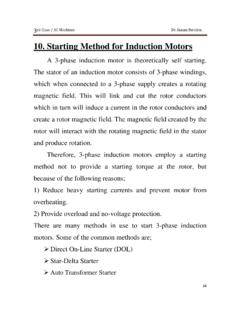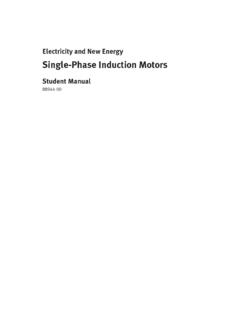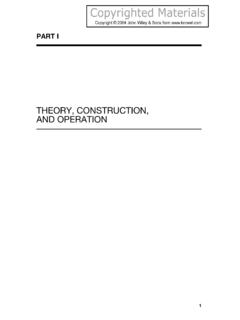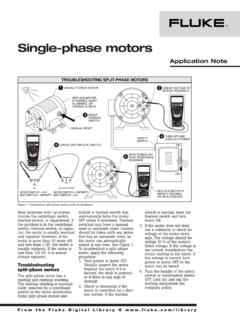Transcription of AN887, AC Induction Motor Fundamentals
1 2003 Microchip Technology 1AN887 INTRODUCTIONAC Induction motors are the most common motorsused in industrial motion control systems, as well as inmain powered home appliances. Simple and ruggeddesign, low-cost, low maintenance and direct connec-tion to an AC power source are the main advantages ofAC Induction motors. Various types of AC Induction motors are available inthe market. Different motors are suitable for differentapplications. Although AC Induction motors are easierto design than DC motors, the speed and the torquecontrol in various types of AC Induction motors requirea greater understanding of the design and thecharacteristics of these application note discusses the basics of an ACinduction Motor ; the different types, their characteris-tics, the selection criteria for different applications andbasic control CONSTRUCTION AND OPERATING PRINCIPLELike most motors, an AC Induction Motor has a fixedouter portion, called the stator and a rotor that spinsinside with a carefully engineered air gap between all electrical motors use magnetic field rotationto spin their rotors.
2 A three-phase AC Induction motoris the only type where the rotating magnetic field iscreated naturally in the stator because of the nature ofthe supply. DC motors depend either on mechanical orelectronic commutation to create rotating magneticfields. A single -phase AC Induction Motor depends onextra electrical components to produce this rotatingmagnetic sets of electromagnets are formed inside any an AC Induction Motor , one set of electromagnets isformed in the stator because of the AC supply connectedto the stator windings. The alternating nature of the sup-ply voltage induces an Electromagnetic Force (EMF) inthe rotor (just like the voltage is induced in the trans-former secondary) as per Lenz s law, thus generatinganother set of electromagnets; hence the name induc-tion Motor . Interaction between the magnetic field ofthese electromagnets generates twisting force, ortorque.
3 As a result, the Motor rotates in the direction ofthe resultant stator is made up of several thin laminations ofaluminum or cast iron. They are punched and clampedtogether to form a hollow cylinder (stator core) withslots as shown in Figure 1. Coils of insulated wires areinserted into these slots. Each grouping of coils,together with the core it surrounds, forms an electro-magnet (a pair of poles) on the application of ACsupply. The number of poles of an AC Induction motordepends on the internal connection of the stator wind-ings. The stator windings are connected directly to thepower source. Internally they are connected in such away, that on applying AC supply, a rotating magneticfield is 1:A TYPICAL STATORA uthor:Rakesh ParekhMicrochip Technology Induction Motor FundamentalsAN887DS00887A-page 2 2003 Microchip Technology rotor is made up of several thin steel laminationswith evenly spaced bars, which are made up ofaluminum or copper, along the periphery.
4 In the mostpopular type of rotor (squirrel cage rotor), these barsare connected at ends mechanically and electrically bythe use of rings. Almost 90% of Induction motors havesquirrel cage rotors. This is because the squirrel cagerotor has a simple and rugged construction. The rotorconsists of a cylindrical laminated core with axiallyplaced parallel slots for carrying the conductors. Eachslot carries a copper, aluminum, or alloy bar. Theserotor bars are permanently short-circuited at both endsby means of the end rings, as shown in Figure 2. Thistotal assembly resembles the look of a squirrel cage,which gives the rotor its name. The rotor slots are notexactly parallel to the shaft. Instead, they are given askew for two main first reason is to make the Motor run quietly byreducing magnetic hum and to decrease second reason is to help reduce the locking ten-dency of the rotor.
5 The rotor teeth tend to remain lockedunder the stator teeth due to direct magnetic attractionbetween the two. This happens when the number ofstator teeth are equal to the number of rotor rotor is mounted on the shaft using bearings oneach end; one end of the shaft is normally kept longerthan the other for driving the load. Some motors mayhave an accessory shaft on the non-driving end formounting speed or position sensing devices. Betweenthe stator and the rotor, there exists an air gap, throughwhich due to Induction , the energy is transferred fromthe stator to the rotor. The generated torque forces therotor and then the load to rotate. Regardless of the typeof rotor used, the principle employed for rotationremains the of an Induction MotorThe magnetic field created in the stator rotates at asynchronous speed (NS).EQUATION 1:The magnetic field produced in the rotor because of theinduced voltage is alternating in reduce the relative speed, with respect to the stator,the rotor starts running in the same direction as that ofthe stator flux and tries to catch up with the rotating , in practice, the rotor never succeeds in catching up to the stator field.
6 The rotor runs slowerthan the speed of the stator field. This speed is calledthe Base Speed (Nb).The difference between NS and Nb is called the slip. Theslip varies with the load. An increase in load will causethe rotor to slow down or increase slip. A decrease inload will cause the rotor to speed up or decrease slip is expressed as a percentage and can bedetermined with the following formula:EQUATION 2:FIGURE 2:A TYPICAL SQUIRREL CAGE ROTORNs120fP--- =where: NS= the synchronous speed of the stator magnetic field in RPMP= the number of poles on the stator f= the supply frequency in HertzslipNsNb Ns--------------------x100=%where: NS= the synchronous speed in RPMNb= the base speed in RPMC onductorsEnd RingShaftBearingSkewed SlotsBearingEnd Ring 2003 Microchip Technology 3AN887 TYPES OF AC Induction MOTORSG enerally, Induction motors are categorized based onthe number of stator windings.
7 They are: single -phase Induction Motor Three-phase Induction motorSingle-Phase Induction MotorThere are probably more single -phase AC inductionmotors in use today than the total of all the other typesput together. It is logical that the least expensive, low-est maintenance type Motor should be used mostoften. The single -phase AC Induction Motor best fitsthis the name suggests, this type of Motor has only onestator winding (main winding) and operates with asingle-phase power supply. In all single -phaseinduction motors, the rotor is the squirrel cage single -phase Induction Motor is not the Motor is connected to a single -phase powersupply, the main winding carries an alternating current produces a pulsating magnetic field. Dueto Induction , the rotor is energized. As the mainmagnetic field is pulsating, the torque necessary for themotor rotation is not generated.
8 This will cause therotor to vibrate, but not to rotate. Hence, the single -phase Induction Motor is required to have a startingmechanism that can provide the starting kick for themotor to starting mechanism of the single -phase inductionmotor is mainly an additional stator winding (start/auxiliary winding) as shown in Figure 3. The start wind-ing can have a series capacitor and/or a centrifugalswitch. When the supply voltage is applied, current inthe main winding lags the supply voltage due to themain winding impedance. At the same time, current inthe start winding leads/lags the supply voltage depend-ing on the starting mechanism impedance. Interactionbetween magnetic fields generated by the main wind-ing and the starting mechanism generates a resultantmagnetic field rotating in one direction. The motorstarts rotating in the direction of the resultant the Motor reaches about 75% of its rated speed,a centrifugal switch disconnects the start winding.
9 Fromthis point on, the single -phase Motor can maintainsufficient torque to operate on its for special capacitor start/capacitor run types,all single -phase motors are generally used forapplications up to 3/4 hp on the various start techniques, single -phase AC Induction motors are further classified asdescribed in the following 3: single -PHASE AC Induction Motor WITH AND WITHOUT A START MECHANISMI nputPowerMainWindingRotorSingle-Phase AC Induction Motor RotorMainWindingInputPowerCapacitorCentr ifugal Switchwithout Start MechanismSingle-Phase AC Induction Motor with Start MechanismStart WindingAN887DS00887A-page 4 2003 Microchip Technology AC Induction MotorThe split-phase Motor is also known as an inductionstart/ Induction run Motor . It has two windings: a startand a main winding. The start winding is made withsmaller gauge wire and fewer turns, relative to the mainwinding to create more resistance, thus putting the startwinding s field at a different angle than that of the mainwinding which causes the Motor to start rotating.
10 Themain winding, which is of a heavier wire, keeps themotor running the rest of the 4:TYPICAL SPLIT-PHASE AC Induction MOTORThe starting torque is low, typically 100% to 175% of therated torque. The Motor draws high starting current,approximately 700% to 1,000% of the rated current. Themaximum generated torque ranges from 250% to 350%of the rated torque (see Figure 9 for torque-speedcurve).Good applications for split-phase motors include smallgrinders, small fans and blowers and other low startingtorque applications with power needs from 1/20 to1/3 hp. Avoid using this type of Motor in any applicationsrequiring high on/off cycle rates or high Start AC Induction MotorThis is a modified split-phase Motor with a capacitor inseries with the start winding to provide a start boost. Like the split-phase Motor , the capacitor start motoralso has a centrifugal switch which disconnects thestart winding and the capacitor when the Motor reachesabout 75% of the rated the capacitor is in series with the start circuit, itcreates more starting torque, typically 200% to 400% ofthe rated torque.



















